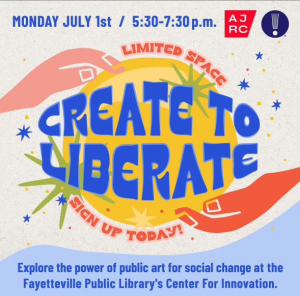Public library provides creative liberation

In what would typically be filled with only the bright lights of computer screens and modern accents was filled with color and delight Monday evening as aspiring artists and activists settled in at the J.B. & Johnelle Hunt Center for Innovation at the Fayetteville Public Library.

Rather than the standard lull of the machines, a lively bunch gathered around to attend the Social Justice Poster Workshop titled “Create to Liberate.”
The class was in partnership with the Arkansas Justice Reform Coalition (AJRC), an organization working to end mass incarceration in the community through the voices of families and individuals that are directly impacted.
Those services include education, direct aid, policy changes and are currently working on their third attempt to try and end cash bail in the state of Arkansas.
Cheanie Noai is an Indigenous Kaqchikel Maya multi-disciplinary artist who has dedicated the past 12 years to grassroots community organizing. She is heavily inspired to create art advocating for migrant rights, queer liberation, child advocacy and climate justice.
For the two hour session, participants learned about the history of public art, joining in group discussions, and understanding the resources available at the local library to help support that creativity.
“In Northwest Arkansas we also get to see a lot of public art that is monetarily supported locally which is an important part of the conversation, but on the opposite end of the spectrum. So when we think of public art as a means of allowing space to give voice to the oppressed what do we see and think that before mentioned these places that aren’t paid for spaces, those are the spaces that I think have the greatest impact because they’re not being silenced and censored by people,” Noai said.
Noai shared that it is important to recognize public art both in the way it has been gentrified and also in the ways people can reclaim it. There is a misconception that there needs to be a large team or many resources to create public art, but people have been visualizing the things we have been fighting against through public art for as long as humans have been around, she said.
“It’s such an important tool and I think having these resources here (at the library) and being able to document the work that we’re doing for people now or people is the future to witness is just so important,” Noai said.
Public art became popular as a way to combat narratives that were being falsely represented in media as a means to share truth, she said.
Some of the examples given were of Paris 1968, Nicaragua 1979 and South Africa in the 1970s which led to revolutionary change as a result.
“It’s wild too, in the history of it, how often public art is actually made illegal. And a lot of money and effort is put toward suppressing public art and that is just ‘how can art be illegal,’” she said.
Following these historical examples, Noai shared the ways people are doing the same today through public art for police violation, mass incarceration, Black liberation, Palestine, Congo and Sudan. “And this art gets to be a place where people can say no,” she said.
Some of the modern day ways people have displayed public art have been through murals on the apartheid walls, a piece created by ambulances that were destroyed during a bombing and the cartoon character Handala.
Following the presentation, another group exercise facilitated the ideas of envisioning what participants see in the future. Attendees shared their ideas of advocating for homes, water, fair representation in the media and access to knowledge.
Then Noai led a guided session on how to utilize Adobe Illustrator in order to create their own public art. Pulling images from the Internet and utilizing layers in the program, people were able to put their ideas into visuals to craft a printed product.
Although the discussions ran long and not everyone was able to walk away with a finished product, attendees are able to return back to the Center for Innovation to pick up their work and create to liberate more often.





Comments